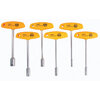I just noticed that my scope base screws were very loose to the point that I'm surprised the scope didn't slide off. I first noticed that the scope was wiggling a bit, and that's what made me check the screws. I had originally tightened them what I thought was a good amount, but did it conservatively because I didn't want to strip the threads.
In the scope mount instructions, it says to tighten the screws 25-30 inch/lbs. Since I don't have a wrench that measures torque weight, I just used my fingers to do the tightening. Is it possible for an average adult male to tighten the base screws to 25-30 inch/lbs. just by using his fingers if he tightened it as much as possible that way? Or would it require a wrench to do that?
In the scope mount instructions, it says to tighten the screws 25-30 inch/lbs. Since I don't have a wrench that measures torque weight, I just used my fingers to do the tightening. Is it possible for an average adult male to tighten the base screws to 25-30 inch/lbs. just by using his fingers if he tightened it as much as possible that way? Or would it require a wrench to do that?




